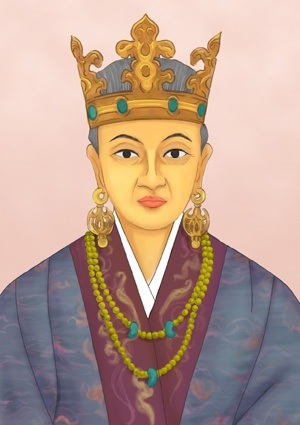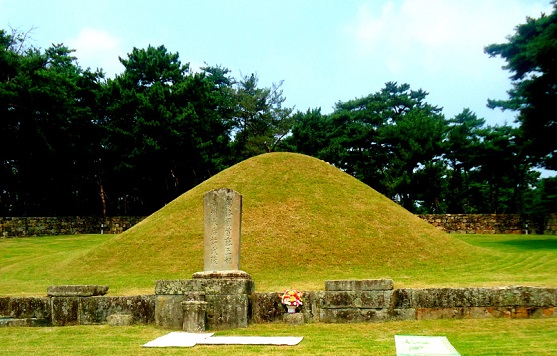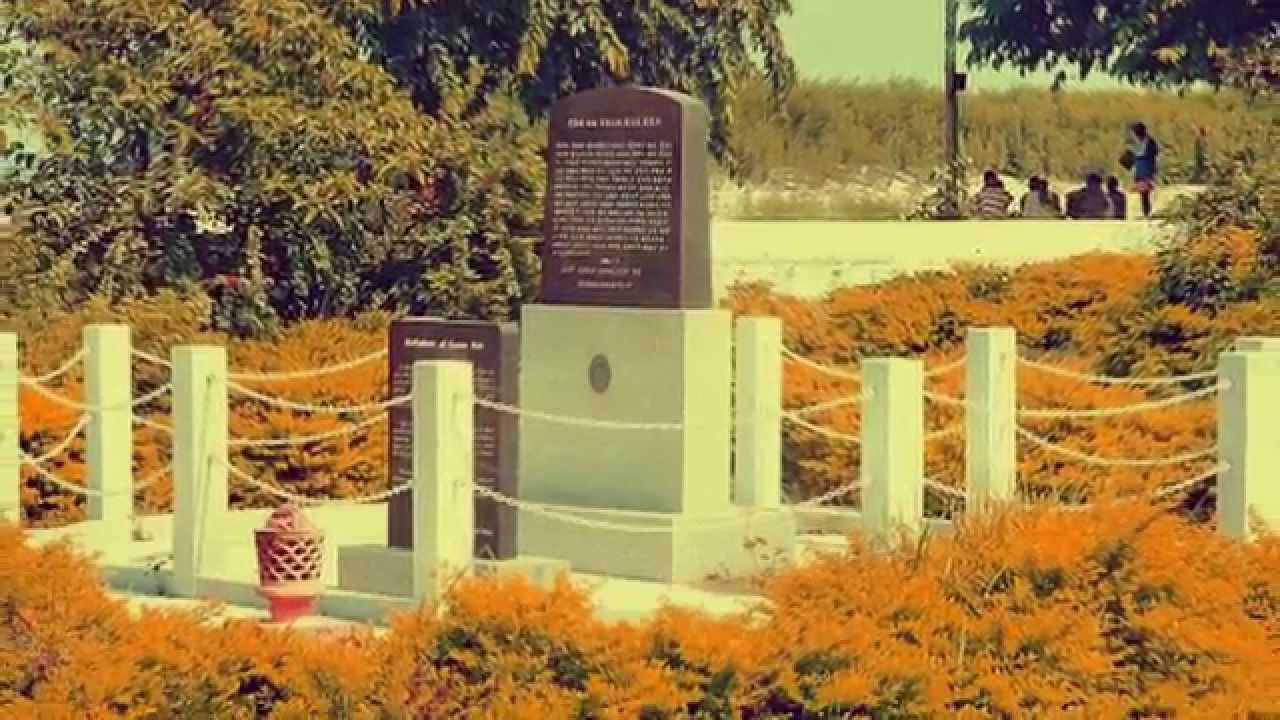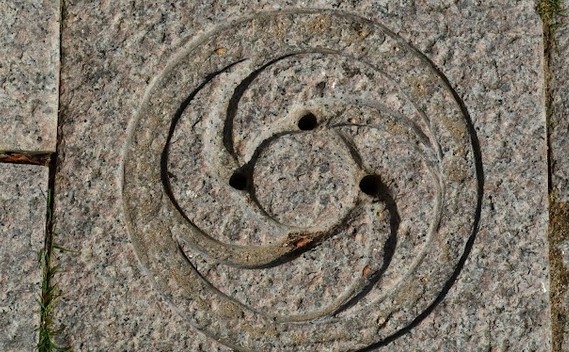Lord Rama's Ayodhya in Korea
Written by : Amita Roy
Dated: May 27,2018
Share

Queen Suri Ratna or Heo Hwang-ok was believed to be born in the royal family of Ayodhya but mysteriously ended up marrying a Korean king in 48 AD.
Ca. 2001
A delegation of more than 100 including of Korean historians and Govt officials comes to Ayodhya in Uttar Pradesh to inaugurate a memorial in honor of their legendary and beloved Queen Heo Hwang-ok. But what is Korean history doing in remote and far off Ayodhya in northern India, which is located extremely at a distant land of India?!

Tomb (in South Korea) of Suriratna, the Princess of the Indian kingdom Ayuta (Ayodhya) and queen of Gaya (in South Korea). The stones used at the bottom, as well as the stone tablet, are distinctly Indian which are said to be taken from India by the Queen herself. Image -Wikimedia
Since childhood, we know that Ayodhya was the place where Lord Rama and his dynasty ruled, as per Ramayana, and of late, Ayodhya has been the center of a political controversy. But there is more to Ayodhya than Rama and Hinduism. Legends has it that Ayodhya shares cultural genesis with Korean Peninsula. Yes, very astonishing and intriguing that how Ayodhya can be in Korea?!
 Memorial of Heo Hwang-ok in Ayodhya set up jointly by both Indian and Korean Govts. Image - Wikimedia
Memorial of Heo Hwang-ok in Ayodhya set up jointly by both Indian and Korean Govts. Image - Wikimedia
Around 48 AD, a princess named Queen Suri Ratna traveled all the way from a far off land to Korea by boat to marry King Kim Suro as a pivot. The first mention of the legend can be found in Garakgukgi or the Record of the Garak Kingdom which is lost currently but its reference is given within the 13th century Korean chronicle Samguk Yusa. As per the chronicle, Suri Ratna was renamed as Heo Hwang-ok. Heo was a princess from far off Ayuta kingdom which many scholars identify as Ayodhya due to the phonetic similarity. Heo was the first wife of the ruler of Geumgwan Gaya and was 16 years old.
King Kim Suro of Gaya in South Korea. Image - Wikimedia
Samguk Yusa mentions that how Heo told Suro about her journey to Korea. She stated that her given name was Hwang-ok or yellow jade. The Heavenly God or Sange Je appeared in her parents dream and orered them to send Heo to Suro, who was the chosen king of Gaya. The dream revealed that Suro had not yet found his queen. Heo’s father told her to go to Suro and from here she started her long sea journey.
In Korea, the courtiers of the King Suro requested him to get married by selecting one of the maidens brought to his court as his wife. But Suro refused by saying that the Heavens has commanded him to wait for his wife who may be coming. He ordered one of his officers to take a horse and a boat to Mangsan-do, an island south of his capital. The official saw a vessel with red sail and red flag. He sailed towards the vessel, escorted it to the shores of present day Kimhae. Another officer went to the palace and informed the king. The king sent his clan chiefs and told them to escort the people of the vessel to the palace.
.jpg)
City of Ayodhya in India / Wikimedia
Heo refused to be escorted by the strangers to the palace. So the king ordered that a tent should be put up on a hill near the palace. The princess arrived there with her courtiers and slaves. The courtiers were Sin Po and Cho Kwang with their wives Mojong and Moryang respectively. The 20 slaves she brought carried her gold, silver, precious jewelry, silk brocade and tableware. The king informed the Heo that God had informed him about Heo’s arrival much in advance for which he never married one of the maidens recommended by his courtiers.
Later after the marriage, some of the escorts of Heo returned home and some stayed back. Those who returned home, received 30 rolls of hempen cloth and ten bags of rice each for the return voyage. Two courtiers from Queen’s original convoy stayed back with their wives. The queen received residence in the inner palace while her 2 courtiers received 2 separate residences.

Gaya Kingdon had symbol of two fish , similar to that of the Ayodhya. which is the state symbol of Uttar Pradesh and is found on almost all the ancient buildings of Ayodhya. Image - Google Images
Suro and Heo went on to have 12 children. Their eldest son Geodeung was the next Kara king. Heo requested Suro that 2 of the children should be allowed to carry her maiden surname. Legendary genealogical traces Gimhae Heo to these 2 children. The Gimhae Kim traces their origins to the other 8 sons. The remaining 7 sons named Hyejin, Gakcho, Jigam, Deonggyeon, Dumu, Jeongheong followed their maternal uncle’s footsteps and devoted to lifelong Buddhism. Overall, almost 7 million Koreans trace their ancestry to Queen Heo. Heo lived up to the age of 157 years.
In Gimhae or Kimhae in South Korea, it is believed that the tombs of Heo and Suro are located. An unusually shaped pagoda brought on a ship is traditionally held. It was built to calm the sea gods and let the ships pass. In 452 AD, a temple in honor of Heo and Suro was built by King Jiji which was known as ‘Wanghusa’ or Queen’s Temple. Among her famous descendents is Gen. Kim Yoo-shin, who first unified the Korean Kingdom in the 7th Century.
.jpg)
Former Korean first lady Kim Yun-ok/ Wikimedia
Contemporary personalities include former President and Nobel laureate Kim Dae-jung and former Prime Minister Kim Jong-pil, former President Kim Young-sam, and the wife of former President Lee Myung-bak (Ms. Kim Yoon-ok). details about how the princess from Ayodhya travelled to Korea and became the Queen are sparse, though there is the work of Prof. Kim Byung-mo and a television series that was broadcast on the Korean TV channel MBC in 2010. In India there have been a few publications, including a book by India’s former Ambassador to Korea N. Parthasarathi, but no extensive academic work done on the issue on both sides.Prof Emeritus of Hanyang University, Prof Byun Mo Kim said that he and 7 million Koreans shares genetic connections with India and considers India as their maternal country. This unknown shared cultural heritage brings hundreds of Korean tourists to Ayodhya every year, especially from South Korea.
